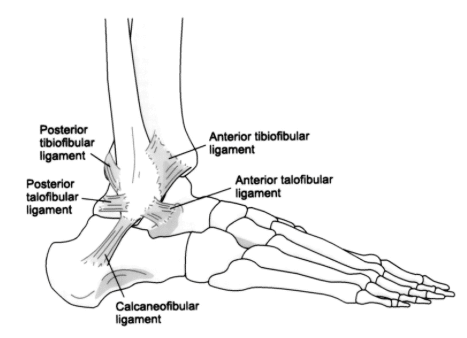Ankle Sprains
What is an ankle sprain?
Ankle sprains are one of the most common injuries seen in sports, with them accounting for 20-40% of all athletic injuries. 85% of ankle sprains are “inversion” injuries, where the ankle is rolled towards the outside of the foot. This can be caused by landing awkwardly from a jump or changing direction quickly. The picture shows some ligaments commonly involved in an ankle sprain; the anterior talofibular ligament (ATFL), posterior talofibular ligament (PTFL) and calcaneofibular ligament (CFL).
An ankle sprain can cause pain around the outside of the ankle, as well as other symptoms such as swelling, bruising and joint stiffness.
Treatment
If you sprain your ankle, seeing a physiotherapist can help manage your pain and the inflammatory process that will start to occur around the ankle. Using the injury treatment method PRICER can be helpful:
Protect– avoid activities that could cause more pain or harm to the ankle.
Relative rest– avoiding activities that cause harm is important, but don’t be afraid to move your ankle around, as this will help with blood flow and the healing process.
Ice– apply ice for 10-15 mins every 1-2 hours to help with swelling and bruising.
Compression– compression bandages and taping can also assist to remove swelling and bruising.
Elevation– putting your ankle in an elevated position can further assist with swelling and bruising.
Referral– it’s important to get medical advice after an ankle sprain to check how extensive the injury is and to determine and plan for your rehabilitation.
Rehabilitation
Although an ankle sprain can appear to be a simple injury, studies have shown that the biggest risk factor for spraining your ankle is having done it before. Up to 30% of people who sprain their ankle end up with residual symptoms such as pain and instability.
Once your pain and swelling have reduced, physiotherapy will start to focus on strengthening your ankle. Ligaments have important roles in stability and proprioception (your ability to tell where your joints are in space), so rehabilitation will focus on elements such as range of movement, balance, strength and coordination. There is emerging evidence that the strength around your knees and hips is linked to the stability of your ankles, so your therapist might look at that too.
The final stage of your rehabilitation will get you back to the activities involved in your specific sport, for example hopping, running and jumping.
How long will it take to recover?
There are lots of factors to consider when determining how long it will take to recover from an injury. If there is no significant ligament damage or fracture, most people can return to sport within 6-8 weeks of injury after an ankle sprain. Studies show that 60-90% of people return to sport at the same level 12 weeks after their injury.

